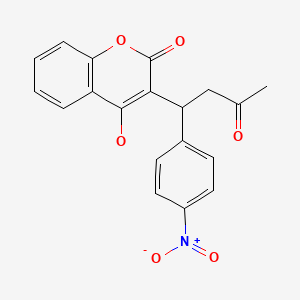Attribution Statement: LactMed is a registered trademark of the U.S. Department of Health and Human Services.
NCBI Bookshelf. A service of the National Library of Medicine, National Institutes of Health.
Drugs and Lactation Database (LactMed®) [Internet]. Bethesda (MD): National Institute of Child Health and Human Development; 2006-.
CASRN: 152-72-7

Drug Levels and Effects
Summary of Use during Lactation
Acenocoumarol is not approved for marketing in the United States by the U.S. Food and Drug Administration, but is available in Canada and other countries. Because of the low levels of acenocoumarol in breastmilk, amounts ingested by the infant are small. No changes in coagulation measurements or adverse reactions in breastfed infants have been reported from maternal acenocoumarol use during lactation. There is a consensus that maternal acenocoumarol therapy during breastfeeding poses little risk to the breastfed infant.[1-3] No special precautions are necessary.
Drug Levels
Maternal Levels. Twenty women were anticoagulated with oral acenocoumarol starting on the first day postpartum with 4 mg, followed by 2 mg daily for 2 days, then adjusted individually based on prothrombin time. After at least 5 days of therapy, milk samples were obtained before and at 1, 4, 7, and 10 hours after the dose. No breastmilk sample had acenocoumarol detected by HPLC assay (lower limit not stated).[1]
Sixteen patients who required anticoagulation immediately postpartum were given acenocoumarol in a dosage according to their clinical need. Two had their dosage titrated to an international normalized ratio (INR) between 1.5 and 1.9, nine were titrated to an INR between 2.0 and 2.5, and 4 were titrated to an INR between 2.6 and 3.5. Milk samples were analyzed for acenocoumarol on days 5, 15, 30 and 45 postpartum. On days 5 and 15 postpartum, acenocoumarol was detectable in only 4 patients at a concentration of 10 mcg/L. On days 30 and 45 postpartum, the average acenocoumarol concentrations in milk from all mothers were 11 and 12 mcg/L, respectively. On these latter days, the average dosage that an exclusively breastfed infant would receive would be about 1.6 and 1.8 mcg/kg daily, respectively, which is far below anticoagulant doses reported in the literature for infants.[4]
Infant Levels. Relevant published information was not found as of the revision date.
Effects in Breastfed Infants
Nineteen infants were breastfed (extent not stated) while their mothers were anticoagulated with acenocoumarol immediately postpartum. Despite not receiving prophylactic vitamin K at birth, none of the infants had abnormal blood clotting as measured by the Thrombotest after at least 5 days of maternal therapy.[1]
Seven infants were exclusively breastfed by mothers who were receiving long-term anticoagulation with acenocoumarol for thromboprophylaxis following heart valve replacement. All women were therapeutically anticoagulated and receiving an average of 21 mg of acenocoumarol per week (range 12 to 45 mg per week). Each infant received 1 mg of vitamin K prophylactically at birth and had their prothrombin time measured after at least 7 days of breastfeeding. The prothrombin times of the infants was not different from those of a control group of 42 breastfed infants whose mothers were not anticoagulated. No instances of bleeding were reported.[5]
Effects on Lactation and Breastmilk
Relevant published information was not found as of the revision date.
Alternate Drugs to Consider
Acenocoumarol, Dalteparin, Enoxaparin, Heparin, Rivaroxaban, Warfarin
References
- 1.
- Houwert-de Jong M, Gerards LJ, Tetteroo-Tempelman CAM, et al. May mothers taking acenocoumarol breast feed their infants? Eur J Clin Pharmacol. 1981;21:61–4. [PubMed: 7333347]
- 2.
- Clark SL, Porter TF, West FG. Coumarin derivatives and breast-feeding. Obstet Gynecol. 2000;95(6 Pt. 1):938–40. [PubMed: 10831996]
- 3.
- Bates SM, Rajasekhar A, Middeldorp S, et al. American Society of Hematology 2018 guidelines for management of venous thromboembolism: Venous thromboembolism in the context of pregnancy. Blood Adv. 2018;2:3317–59. [PMC free article: PMC6258928] [PubMed: 30482767]
- 4.
- Nava LE, Gómez AB, González VM. Ginecol Obstet Mex. 2004;72:550–60. [Plasma and milk concentrations of acenocoumarin in breast-feeding women during post partum] [PubMed: 15986763]
- 5.
- Fondevila CG, Meschengieser S, Blanco A, et al. Effect of acenocoumarine on the breast-fed infant. Thromb Res. 1989;56:29–36. [PubMed: 2595672]
Substance Identification
Substance Name
Acenocoumarol
CAS Registry Number
152-72-7
Disclaimer: Information presented in this database is not meant as a substitute for professional judgment. You should consult your healthcare provider for breastfeeding advice related to your particular situation. The U.S. government does not warrant or assume any liability or responsibility for the accuracy or completeness of the information on this Site.
- User and Medical Advice Disclaimer
- Drugs and Lactation Database (LactMed) - Record Format
- LactMed - Database Creation and Peer Review Process
- Fact Sheet. Drugs and Lactation Database (LactMed)
- Drugs and Lactation Database (LactMed) - Glossary
- LactMed Selected References
- Drugs and Lactation Database (LactMed) - About Dietary Supplements
- Breastfeeding Links
- PMCPubMed Central citations
- PubChem SubstanceRelated PubChem Substances
- PubMedLinks to PubMed
- Review Warfarin.[Drugs and Lactation Database (...]Review Warfarin.. Drugs and Lactation Database (LactMed®). 2006
- Review Phenprocoumon.[Drugs and Lactation Database (...]Review Phenprocoumon.. Drugs and Lactation Database (LactMed®). 2006
- Review Chloramphenicol.[Drugs and Lactation Database (...]Review Chloramphenicol.. Drugs and Lactation Database (LactMed®). 2006
- Review Labetalol.[Drugs and Lactation Database (...]Review Labetalol.. Drugs and Lactation Database (LactMed®). 2006
- [Metabolism of a derivative of 4-hydroxy-coumarin: 3(alfa-acetonyl-p-nitrobenzyl)4-hydroxy-coumarin (Sintrom) in man].[Rev Fr Etud Clin Biol. 1968][Metabolism of a derivative of 4-hydroxy-coumarin: 3(alfa-acetonyl-p-nitrobenzyl)4-hydroxy-coumarin (Sintrom) in man].Blatrix C, Charonnat S, Tillement JP, Israel J, Brevet JP, Debraux J, Merlin M. Rev Fr Etud Clin Biol. 1968 Dec; 13(10):984-95.
- Acenocoumarol - Drugs and Lactation Database (LactMed®)Acenocoumarol - Drugs and Lactation Database (LactMed®)
Your browsing activity is empty.
Activity recording is turned off.
See more...
